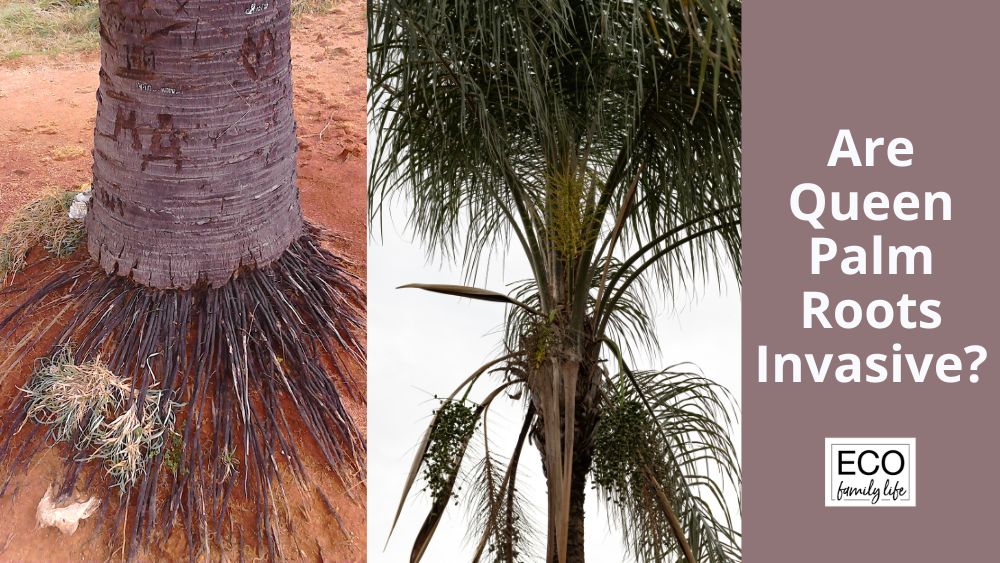Queen palms are an attractive tree that do well in tropical or subtropical climates, such as the southeastern United States. The root system is noninvasive, mostly because the roots are thin and not heavy and because they don’t grow very deep.
Queen palms will have a shallow root system even when they are established reaching around 4 feet deep. While their roots can spread wider they are not invasive.

The root system of a queen palm tree is weak and shallow, which is also one of the reasons why they often blow over in strong winds or when a hurricane hits.
Do Queen Palm Trees Have Deep Roots?
The roots of a queen palm tree can grow one to four feet deep underneath the soil, but usually no more. This is considered to be a shallow root system.
The roots also spread out no more than 12 feet in width because they grow as wide as the fronds, which usually get to 12 feet or less.
If your palm tree’s fronds spread out more than 12 feet, you can safely assume that the roots are going to spread out that far as well. But as far as the depth of the roots, queen palm trees do not get very deep.
How Big Is the Root Ball on a Queen Palm?
The root ball of a Queen palm will usually be up to 4 feet deep but can reach 12 feet wide when the plant is mature.
Keep in mind that the roots of a queen palm tree also tend to be rather thin, so the odds of them causing any damage to any nearby structures are very low. This doesn’t mean it can’t happen, but it is very rare.
Can Palm Tree Roots Damage a Foundation?
Generally, there is no need to worry about palm tree roots damaging the foundation of your home. The roots that belong to palm trees tend to be thin and narrow and therefore don’t have the strength to cause any damage to a heavy foundation.
The roots tend to remain the same size as the tree gets older, so there’s no need to worry about them getting bigger or heavier as the tree ages.
How to Stop Palm Roots From Damaging Concrete, Pavers, or Other Structures
Most experts recommend planting queen palms at least 6 feet away from concrete, pavers or other structures.
Remember that the size of the fronds can tell you roughly how far out your roots will likely spread in width. Some palms can reach a width of 12 feet so if you plan on allowing it to grow to maturity then allow more room.
4 Ways to Remove Queen Palms
The odds of queen palm roots becoming invasive are very small, mostly because the roots are thin, narrow, and not very aggressive. If you want to remove your queen palm altogether here are some easy tips.
1. Starve the Queen Palm of Sunlight
Palm tree roots can’t grow if they don’t have sunlight. One of the things you can do is take thick landscape fabric and cover the entire root system. This is a slow remedy because you’ll probably have to leave it there for about a year.
The fabric prevents the new shoots from breaking through the soil, and to make it look nicer in the meantime, you can cover the fabric with large stones or with sand. In the end, you’ll want to go ahead and dig up the dead roots so you can get rid of them.
2. Physically Remove the Roots
This is a physically demanding remedy, but it works. Remember that palm trees grow best in sandy soil, so you’ll want to start this job when the soil is dry.
When too wet, sandy soil is simply too heavy and difficult to work with and maneuver. The first thing you should do is cut the stump down to a manageable size, then cut a trench all the way around the stump.
Use a hatchet or shovel to sever all of the roots found on or near the stump.
Working outward, plunge the shovel deep into the soil and lift up the roots, discarding them in a bag but shaking loose the soil so that it falls to the ground. It’s best if you do this one section at a time.
3. Get Rid of the Stump
You can have trouble with the roots if your trees are still there, but if you cut the tree down to a short stump, you can use a stump grinder to get rid of the rest of it.
Let’s face it, the best way to contain roots is to get rid of them, and you can rent a stump grinder after using a chainsaw and cutting it into smaller pieces, then renting a stump grinder to take care of the rest.
Once the tree stump is gone and you give it some time, the roots will begin to die.
4. Use a Chemical Killer
You can also use chemical root killers (herbicides) to kill off queen palms.
Herbicides tend to be bad for the environment and therefore people usually only use them as a last resort, but they are very effective in getting rid of the roots of all types of palm trees, including queen palm trees.
You can cut the palm tree off as low as possible and then place herbicide onto the stump.
Single stemmed palms like queen palms will die once their stem has been cut. The herbicide will just kill the roots quicker.
Conclusion
Queen palm roots are typically thin and noninvasive. For this reason, it is very unlikely these trees will cause you any problems unless they are planted very close to your foundation, pavers, concrete, or other structures.
Happy growing.
I am an accredited practicing dietitian, experienced gardener and a dedicated cook. I love writing and sharing my experience so you can learn from my successes and mistakes.
